Big Canoe

Beez Neez now Chy Whella
Big Bear and Pepe Millard
Sun 25 Oct 2015 23:47
|
The Big Canoe on the Grass
Behind the Beach in Anelghowhat Bay
 We saw this lady the first time we came ashore.
Today we asked about her.
She is/was a government sponsored initiative to
build and journey with sail and paddles to the Loyalty Islands, part of New
Caledonia. She was completed nine months ago and she was indeed test sailed
around the bay but with Cyclone Pam the project has been delayed, hopefully not
abandoned.
On our visit to the
Cultural Centre in Port Vila we read the following information.
The
revival of sailing. Since Independence in 1980, there has been a steady
revival and interest in the art of sailing in Vanuatu. In that year a group from
Atchin Island off north-east Malekula built the first large double-ender sail
canoe in almost a hundred years and sailed it to the Pacific Arts Festival being
held in Port Moresby, Papua New Guinea. In the early 1990’s, the Vanuatu
Fisheries Department started a program to re-introduce sailing to remote areas
in an effort to support the traditional canoe building skills found throughout
the country to assist with fisheries development of rural areas. With support
from that program, numerous communities in Vanuatu, from Aneityum Island in the
south to the Torres Islands of the north have revived
sailing.
In 1995 two
ten-metre canoes were sailed to Port Vila to commemorate the opening of the new
National Museum, one canoe from Maewo Island and the other from Atchin Island.
In 1998, a group from Aneityum sailed the ten-metre Dayspring IV to
Port Vila as part of the Presbyterian Church’s Golden Jubilee
Celebrations.
More
recently, the Vanuatu Cultural Centre has assisted in the revival of some of the
ancient traditional sail designs that had been lost for almost a hundred years.
In 1999, the community of Anelghowhat of Aneityum reconstructed from their
collective memory the oceanic lateen sail formerly used throughout most of the
southern islands. This reconstruction, woven entirely from pandanus leaves in
the traditional fashion, was on the canoe that took part in the Te Ngaru Matua
[The Ancient Wave] Oceanic Waka Festival held in New Zealand in March 2000. The
style of canoe cut for this event was also the style formerly found on Aneityum
and lost about thirty years ago.
The ‘wing tip’ or
oceanic spritsail of central and northern Vanuatu was also revived as part of
the Te Ngaru Matua event. This sail, unique to this part of the world was fitted
to a traditional canoe from Lelepa Island of north Efate and complemented the
canoe from Aneityum.
Canoes, both sail
and paddle, remain an important part of island life for transport, fishing,
trips to the garden and island travel throughout the archipelago. Its
contribution to Vanuatu’s cultural heritage, traditional and formal economy and
sense of self-reliance, identity and independence warrants further recognition
and support to ensure the skills and natural materials are maintained into the
future.
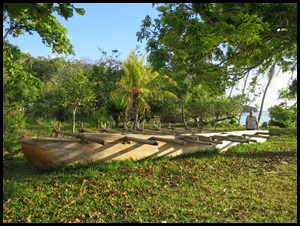 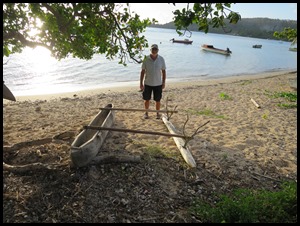 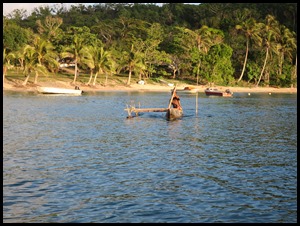 Bear looks
miniscule standing behind her and compared to what we
are used to seeing spuddling about the bay, she is massive.
Inter-island voyaging and trade canoes. Inter-island
trade depended on the large carved and planked outrigger canoes formerly found
throughout the islands. These were the ships of the past, fitted with sail and
having crews of up to thirty men. These canoes were considered sacred, as were
the trade voyages they went on. In some areas of Malekula, up to a hundred
tusked pigs would have been sacrificed by the time one of these inter-island
canoes was launched. In this way, the canoe was sanctified and empowered with a
name, a grade in the traditional hierarchy and a spirit to ensure successful
voyages. On the northeast of Malekula sanctifying rituals included the placement
of a stylised bird on the canoe ends to indicate its owners
rank.
Styles of inter-island canoes varied considerably
from one island to the next from north to south in the archipelago and reflected
the cultural diversity amongst islands. Generally, they were built up from a
carved log used as a keel with washboards [planks] sewn on to increase
freeboard. Various types of tree resins and techniques were drawn on to caulk
these sewn joints. The particulars of the canoe’s construction were often
specified by the areas ancestral cultural hero, as were the taboos associated
with its construction and use. In some areas a different language was spoken
while at sea.
The types of wood used to construct the hull varied
amongst the islands following the different trees preferred and available. Trees
commonly used included durable woods such as breadfruit, rosewood, ironwood or
softer, lighter woods like whitewood. A large sail canoe may include a dozen
different woods carefully chosen for each particular characteristic including
strength, flexibility, lightness and resistance to cracking, weathering and
insect attack.
Successful inter-island voyages also required
extensive local knowledge currents, tides, winds and weather prediction as well
as knowledge of the stars and other navigational
techniques.
  Built solidly in the
traditional way.
Styles of Sails.
At the time of European contact, there were two main categories of sail found in
Vanuatu. The southern islands of TAFEA [Tanna, Aniwa, Futuna, Aneityum and
Erromango] used an oceanic lateen style of sail. This type of sail is considered
to have been refined by the Micronesians, adopted by the Polynesians and
introduced to southern Vanuatu some eight hundred years ago during the
Polynesian back-migration to the Western Pacific. This type of sail is shunted
[changed from end to end], which allows the outrigger to always face the wind as
opposed to the European method of tacking through the wind. It was lost fairly
early after European contact but it has been revived on Aneityum
Island.
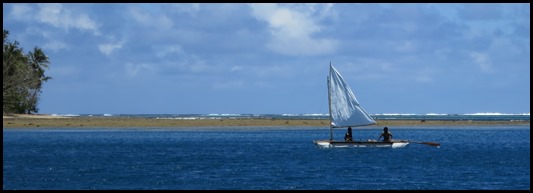 A little fishing
canoe we see out and about every day.
The central and northern islands
of Vanuatu used a sail called the oceanic spritsail. A more descriptive name is
the ‘wing tip’, as it resembles the wings of a bird. Europeans called it the
‘butterfly’ sail when they first saw it. The ‘wing tip’ is unique to this part
of Vanuatu and is found nowhere else in the world. It survived until the early
1900’s when European sails displaced it. It resembles the extremely efficient
delta-foil shape utilised on high speed jets and is known to develop additional
power through creation of ‘vortex lift’.
The Shepherd Islands from north
Efate to southern Epi, being culturally distinct with evidence of other
Polynesian influences had their own variation of the oceanic spritsail, it being
more triangular in shape.
All of the larger inter-island
canoes were always sailed with the outrigger facing the wind. Its tendency to
fly in a strong wind was balanced by shifting cargo and crew weight out over the
outrigger itself. The sail rig of the oceanic spritsail could be changed to the
opposite end of the canoe, if necessary during a trip, but as most voyages were
less than a hundred miles, this wasn’t normally necessary. For the return trip
the mast would simply be shifted to its new position before departure. There was
always a strong tradition of weather specialists who foretold the weather by
reading winds and clouds as well as influencing the weather through ritualised
practices.
 One of the support
beams.
Styles of sails in Vanuatu today. The types of sail
found today are all based on European styles that were introduced about a
hundred years ago. The European spritsail is the most common type of sail found
today. Areas where it is still used include Lamen Bay on Epi Island, the
Maskelyne Islands of southern Malekula and some islands in the Banks Group. This
style of sail was introduced in Aneityum in the 1990’s and has become popular.
Increasingly, some of these islands use a small triangular ‘leg of mutton’ sail
as well.
The small islands
of northeast Malekula, once a great centre of sailing and trade, now use a
European ‘balanced lug’ style of sail. This sail allows the outrigger to always
face the wind as was the case traditionally with central Vanuatu’s large ‘wing
tip’ rigged canoes. The introduced ‘balanced lug’ sail somewhat resembles the
oceanic lateen sail that was traditionally found in southern Vanuatu, but
differs in that the sail is not shunted when changing tack, but simply swung
around the mast.
In some
areas, coconut leaves are arranged on canoes as temporary sails to take
advantage of following winds.
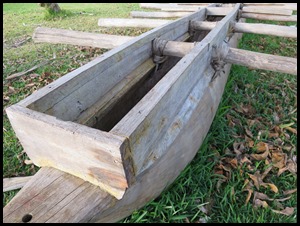 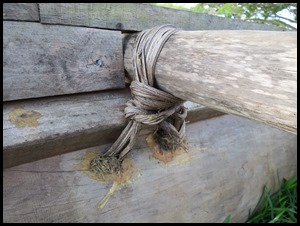  Sad
to see one or two nails. All the
strapping would need to be replaced before this lady could set off.
The
demise of inter-island canoes and disruption of traditional trade. The
arrival of the Europeans had a drastic impact on traditional shipping and trade
in Vanuatu. Starting with the sandalwood trade around 1830, it became dangerous
to be caught offshore in a canoe. Canoes would be rammed and shattered so as to
capture the crew and cargo to be traded to their neighbouring enemies for
sandalwood. The ‘blackbirders’, in general an equally unscrupulous bunch, began
arriving in the 1860’s to recruit or sometimes enslave for Queensland and Fijian
sugarcane plantations. They would target the large canoes found offshore as a
source of easy ‘recruits’ by ramming them and hoisting the crews aboard their
ships bound for Queensland.
Many early
missionaries were intolerant of traditional practices and forbade canoe voyages
associated with traditional trade and rituals while finding their work easier if
the ‘natives’ were a little less mobile. The whalers, copra traders and planters
arrived in the mid to late 1800’s to alienate land, trade in firearms and
spirits and to introduce the European whaleboat with European style sails. They
also introduced disease, coupled with labour trade, severely depopulating many
islands. As the first Europeans always arrived by sea, their disruptive
influence was first felt in the coastal areas. The maritime skills of the old
canoe builders, sailors and navigators were one of the early victims of European
contact.
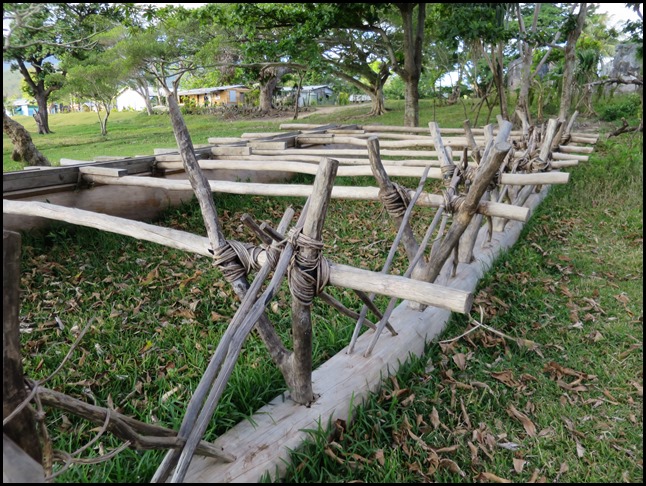 The outrigger is carved
from one tree trunk.
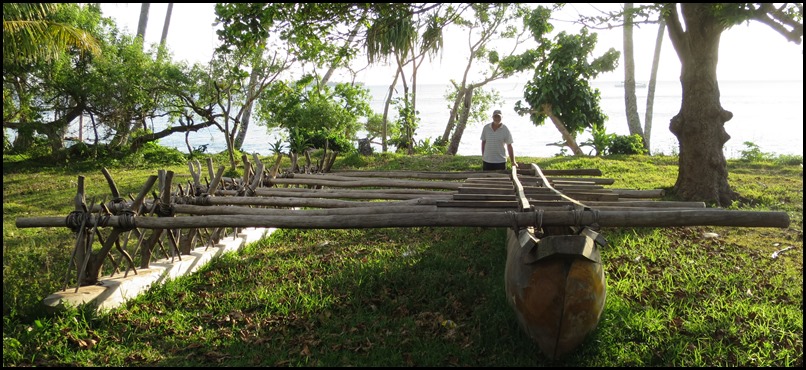 Some trees
would have to be taken out of her way to get her into the
water.
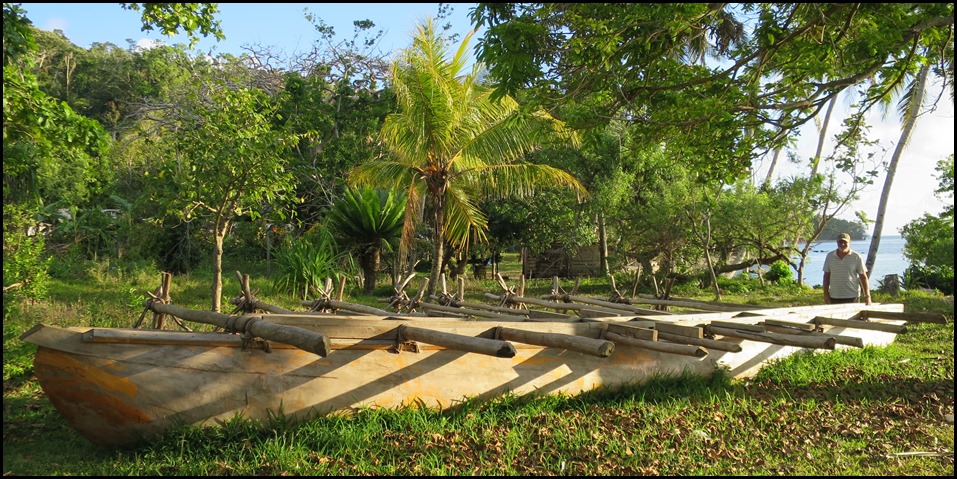 A
lick of varnish and a little TLC, we wish the lady safe
winds and a following sea.
ALL IN ALL QUITE A
VESSEL
A VERY SMART
LADY |